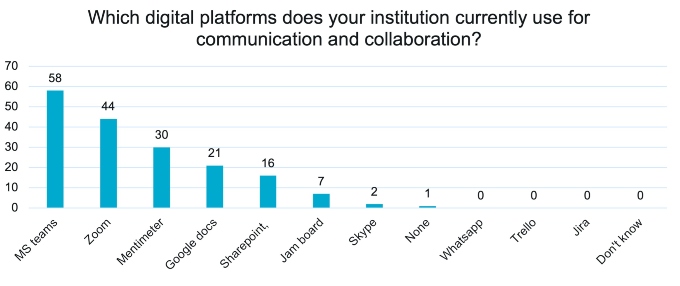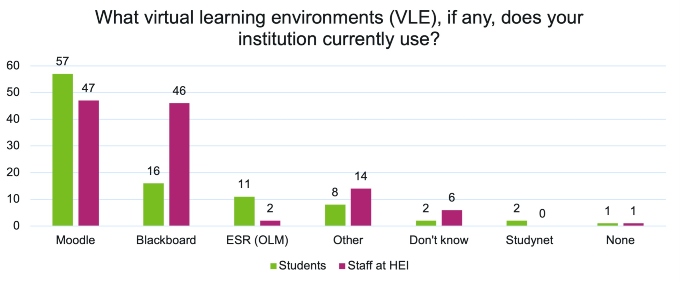What digital technologies are being used?
Key findings: The digital technologies and methodologies currently used in health and care educationFind out what digital technologies are being used.
Digital technologies are being incorporated into teaching and clinical practice, with the majority of students and practice education facilitators reporting they are used often (Figure 5 and Figure 6).


Whilst these charts show a large proportion of students access digital technologies, the use of digital technologies was found to be largely for communication and collaboration purposes (Figure 7). These technologies for communication and collaboration were used for both admin purposes and to enhance education. For example, video conferencing was identified as a theme in at least 144 responses in the survey, often used for content delivery, and virtual learning environment (VLE) was identified as a theme in at least 84 responses. When asked which digital technologies they used for communication and collaboration, students responding to the survey identified platforms like Microsoft Teams (~31 responses), Moodle (~22 responses) and Zoom (~14 responses) most frequently. Additionally, when presented with a list of digital platforms, students identified Microsoft Teams as the most commonly used platform at universities and on placements (Figure 7 and Figure 8).


Regarding VLEs, staff and students reported Moodle as the most used platform by universities (Figure 9). This is also reflected in the qualitative responses.

However, some digital technologies used to enhance education through supporting safe practice were mentioned by an even greater number of participants in the survey. Specifically, virtual reality was identified as a theme in at least 170 responses and virtual simulation was identified as a theme in at least 120 responses.
Virtual placements were also identified as an option available to some students. One student reported that they felt this increased their opportunities to engage with digital technologies. In the focus groups and case study interviews, virtual placements were described as working in roles in a virtual capacity (for example, working from home when placed in an organisation and conducting psychology consultations with patients online and engaging with colleagues online for most of their working week).
Other technologies being used were described as:
- online resource (for example, online libraries, journals, eBooks, online videos)
- custom designed digital platforms
- immersive technologies (for example, augmented reality (AR))
- wearables (for example, goggles, go-pro)
- robotics
- medical devices and imaging technologies (for example, magnetic resonance imaging (MRI), x-ray)
- devices to access online information (for example, mobiles, tablets, laptops)
- Microsoft Suite
- apps and digital platforms (for example, eLearning)
- record keeping technologies (for example, Electronic Patient Records (EPRs))
- social media (for example, Twitter, LinkedIn)
- cloud based storage (for example, SharePoint)
- audience response systems (for example, Kahoot, Mentimeter)
- ePad
- online assessment software
- telemedicine (via video link and phone call)
Additionally, 1 survey participant identified that it would be beneficial for digital health and care to replicate the genomic programmes run by Health Education England (HEE) at the time of the research, and now NHS England (NHSE). This was the only occasion genomics was mentioned, despite genomic sequencing being a common theme in other reports on digital health and care, such as the Ives Nursing and Midwifery Review.
Page last reviewed: 10 May 2023
Next review due: 10 May 2024